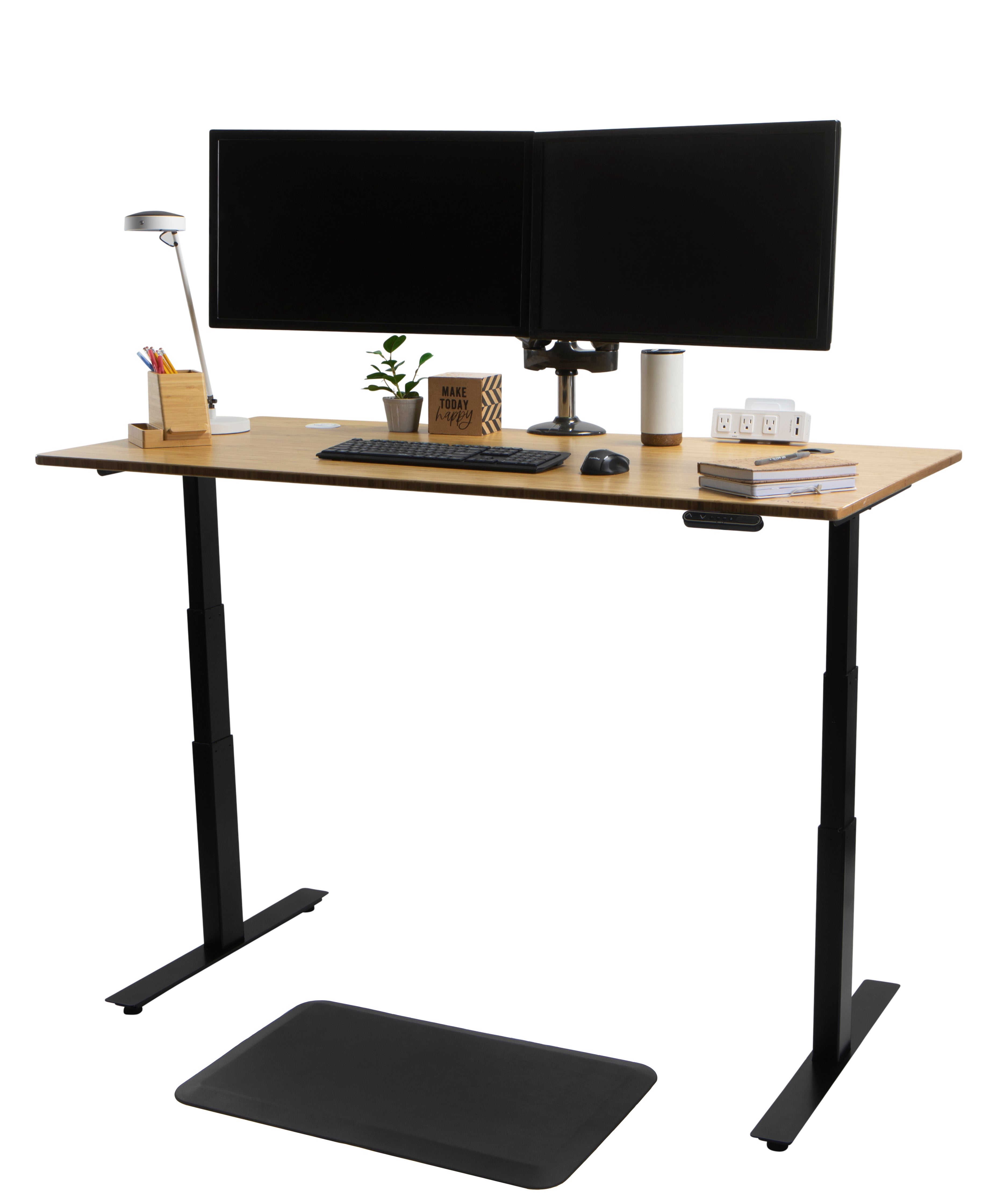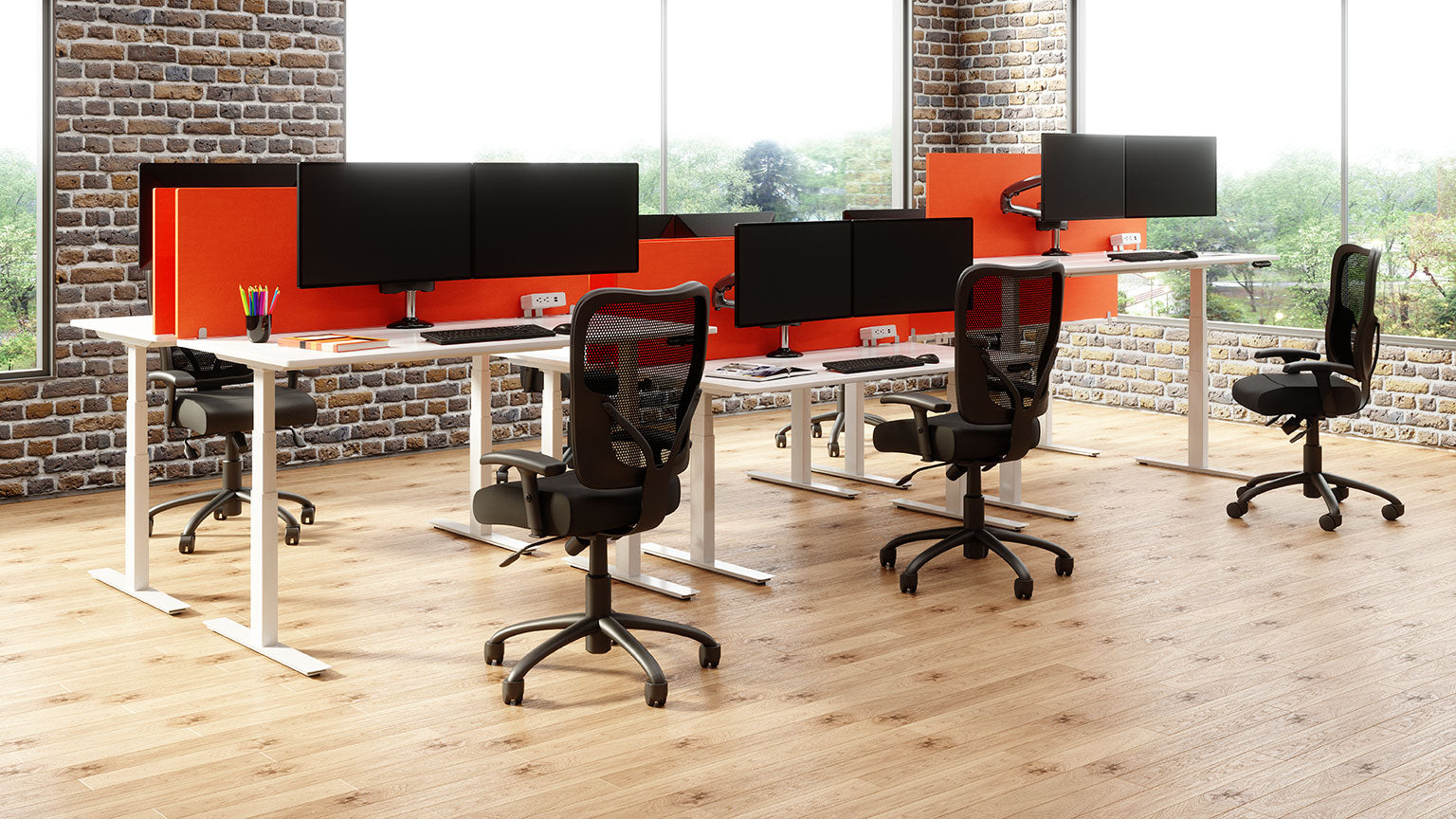
5 Best Ways to Situate Your Standing Desk Monitor for Optimal Comfort
The 5 Best Ways to Situate Your Standing Desk Monitor Height for Optimal Comfort
Your desk is your workshop. It's where your genius flows, and that's why you need working there to feel good. If you use a standing desk, no doubt the promise of feeling good and experiencing multiple health benefits influenced your decision. While avoiding too much time sitting down is a win for good health, monitor height plays a major role when standing comfortability at your desk.
Designed and built in Denmark, HomeBase brings commercial-grade materials and engineering into your workspace with over 100+ customizable sizes, colors and worksurface combinations.
For All Day Comfort, Monitor Height and Position Matters
We totally understand: You are never without your laptop. It's the best (and worst) thing to happen to work productivity since... ever. The thing is, marrying the screen to the keyboard is about portability, not all-day usability. Laptops were first designed as an alternative to a desktop computer... Then computing power caught up and we never felt the need to put them down.
So we stay on our laptops (or phones) and we just keep looking down instead of being at eye level with the screen. This can lead to neck strain and other health issues down the road.
Major Health Reasons to Take Monitor Position Seriously
1. The New Neck Strain: Text Neck! What?
It's real, and it's a big deal. According to research by Dr. Kenneth Hansraj, looking down at too sharp an angle for hours every day (as we do while using laptops and phones) substantially strains the spine and can lead to long term damage over time.
And what happens when you try to show a co-worker your screen? You all hunch over and squint at it. Not good. If sharing is caring, a standing meeting around an upright screen is divine. Using a laptop on a desk is better than on the couch, sure, and a standing desk is better still. However, it's still a laptop, and all day use is going to catch up with you. So chin up, buttercup!
2. Eye Strain
It's normal to end up nose-to-nose with your monitor or with lights that cause glare and then putting up with them for hours because you're just so dang focused. I, for one, am now the proud owner of "computer glasses" prescribed to me by my eye doctor for computer vision syndrome. Apparently staring at a screen all day isn't what eyes were made to do. While you probably can't choose to look at your computer screen any less, you can take steps to mitigate how much you work your baby blues, including moving it further from your eyes than a laptop allows.
3. Variability
Standing is awesome partly because it's so easy to move. A desk lean here, a knee-bend there helps to give some muscle groups a rest while stretching others and improving blood flow. Positioning your monitor up and away from your keyboard helps encourage you to detach from your "downward computer" stare, which is totally not a yoga position.
Beyond alleviating neck and eye strain, feeling free to move at your workstation can relieve stress in your back, shoulders, knees, elbows and wrists. An adjustable monitor arm lets you do that. And spinning your monitor vertically, for a reading and editing change of pace, that's just too cool for school.
4. More Desk Space
When you can have things you need all in arm's reach because your monitor is up and out of the way, you can grow sticky note gardens, paper stack cities, or have more space for, you know, actual plants, or even good old fashioned blank desk space.
Wait, having more desk space is not a health issue, you say? Depends on who you ask. If you're ever confronted by a sense of overwhelm or indecision at work, your cluttered physical surroundings could be partly to blame. Or maybe you just need more space to grow your piles, you little Einstein, you.
OK, so that's why you should consider how your monitor position affects your work. Here's how to get it right.
5 Step Checklist to Find Your Perfect Monitor Position
- Height - Position the top of your monitor about as high as the top of your head so you look down slightly (about 20 degrees) to the center of the screen. If you've been thinking about posture a lot lately, you might be inclined to place it up high and stand at attention. That's not bad from time to time, but it can strain your neck, just like too much looking down.
- Distance - The middle of the screen should be 1.5 to 3 feet away from your eyes, ideally on the longer end for a comfortable distance.. Being able to stand back an additional couple feet throughout the day is also a good choice, but you don't want to be gazing into the distance all day—that can be just as straining as standing or sitting too close. If you like standing at a longer distance from your monitor, consider zooming in a little by decreasing your screen resolution.
- Angle - Tilting the monitor screen slightly back so it's perpendicular to your eyes is helpful. This is how your screen was meant to be viewed, after all. A slight screen tilt also helps reduce glare from overhead lights, or light sources behind you. Speaking of light...
- Light - Watch out for glare, especially as lighting changes throughout the day. Single-source lights can tire your eyes, as can high contrast between your screen and the rest of the room or a window. Although your screen may provide the only light you truly need in order to work, a dark room at the edges of your vision increases eye strain.
- Movement - Adjusting your desk to sit from time to time or changing your standing positions for comfort or sharing your monitor with others are all good reasons to tweak how your monitor is oriented to you, not just once, but many times throughout the day.
Of course, a monitor arm makes it quick and easy to make all of these adjustments, so you can get your monitor exactly where you want it, in your very own Goldilocks zone.
The Freedom Arm® is a stylish articulating monitor arm that easily mounts to any standard desk (or wall) allowing you to free up valuable desk space.
While no one desk set up will be just right for everyone, it's important to know where to start and end. In other words, you will naturally change your position regularly, but if you know the right "neutral position," you can guard against a creeping hunch or other unhelpful posture habits, like the ones your laptop friend so diligently encouraged over the years.
Try a properly situated monitor for just an hour and you're not going to want to go back. Ergonomics, my friend. Ergonomics.



